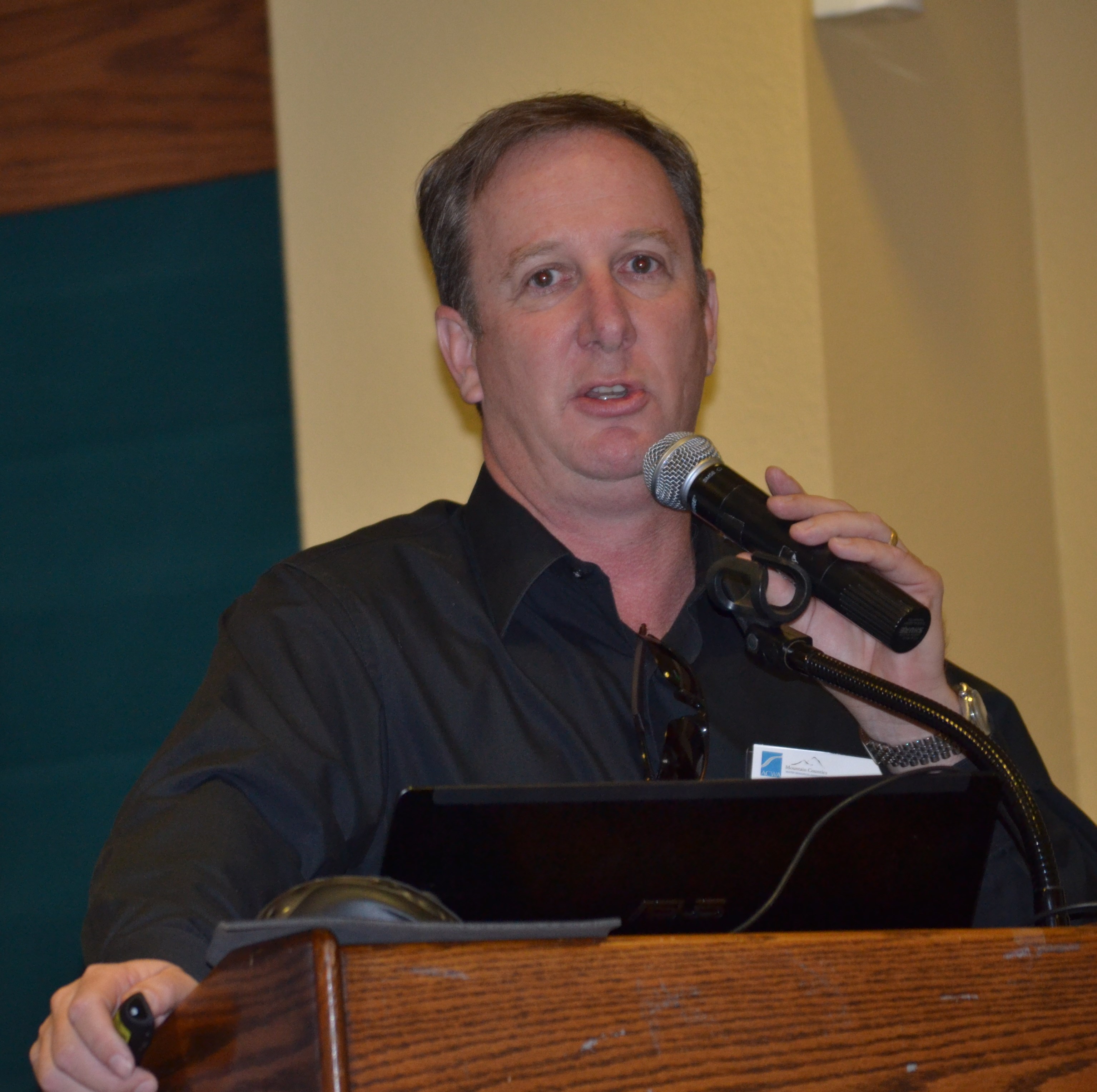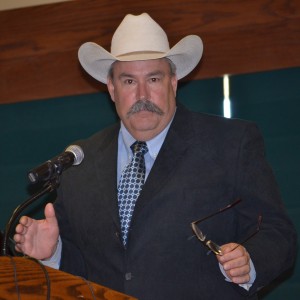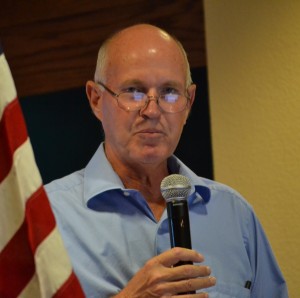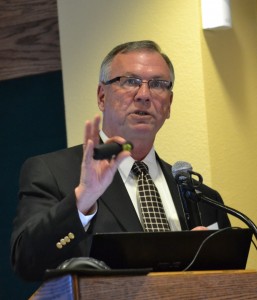Mountain Counties presents status of efforts to meet today’s water challenges
By Roberta Long
MCWRA Writer
At the joint meeting of Mountain Counties Water Resources Association (MCWRA) and the Association of California Water Agencies (ACWA) Region 3 on Oct. 18, at the Ridge Golf Course and Events Center in Auburn, approximately 85 people heard from state, legislative and water agency leaders about statewide efforts to reconcile competing water interests. Mountain Counties has been an active participant in these efforts.
The call to integrate water management
 California Department of Water Resources Deputy Director Gary Bardini described the department’s efforts to promote integrated water management. He started with today’s challenges. “The economic climate has changed,” he said. The last water bond was passed in 2006. The funds from that $23 billion bond approved by voters are running out. Voter support for more bonds is declining, he said.
California Department of Water Resources Deputy Director Gary Bardini described the department’s efforts to promote integrated water management. He started with today’s challenges. “The economic climate has changed,” he said. The last water bond was passed in 2006. The funds from that $23 billion bond approved by voters are running out. Voter support for more bonds is declining, he said.
At the same time, the need is great. Forecasting the amount and timing of rain and snowfall to expect in future years is a major challenge. In the immediate future, what we do know is that California has a history of periodic multi-year droughts. In 1977, the state received the lowest amount of water on record. In 2011 the major reservoirs were topped off with a sufficient supply. The 2012 year was another dry one, and the reservoirs were drawn down again. As California goes into its third dry year, the reservoirs are not holding much carryover, and groundwater is being used as agricultural backup. The state and federal projects will have the lowest deliveries ever because of the lack of rain this year, he said.
Given all the circumstances, one of the questions is what water facilities and programs to invest in, both local and statewide. Bardini said, “We need everything to provide reliability. We need multi-benefit solutions.”
Bardini said water management has become more complex while the way of doing business remained substantially the same, with each agency pursuing a single purpose, and either ignoring or colliding with other agencies. No one agency can solve all its problems alone, he said. Integrated regional water management is becoming a necessity for regional urban and rural areas.
The Department of Water Resources is supporting Water 360, a campaign that brings state, federal and local water leaders together. Bardini said that programs and projects that cross watershed and jurisdictional boundaries will have multiple benefits.
View from the California Legislative Rural Caucus
 Cattleman Frank Bigelow, from O’Neals in Madera County, said that when he campaigned for a seat in the California Assembly in 1998, water was not an issue. It became an issue in 1999, when he became involved with efforts to restore the San Joaquin River.
Cattleman Frank Bigelow, from O’Neals in Madera County, said that when he campaigned for a seat in the California Assembly in 1998, water was not an issue. It became an issue in 1999, when he became involved with efforts to restore the San Joaquin River.
As Assemblymember for District 5, Bigelow represents constituents from Placer to Madera counties, including South Lake Tahoe and Yosemite. “I use my mind in an open way to get understanding and forget the ‘bs,’” he said.
Bigelow is chairman of the California Legislative Rural Caucus, which is bipartisan and has members from the Assembly and Senate. “The rural issues are: a better life, kid, jobs, community and the economy, he said. “Each community is unique.”
He agrees that the state’s economy revolves around water. He suggested bringing legislators who are not familiar with the range of water issues by to the places where the problems are. “Expose them to what we have lived with all our lives,” he said.
MCWRA Executive Director John Kingsbury said in an interview after the program that he “appreciates the Assemblymember’s assertive leadership, determination, and focus on the challenging water issues critical to the economy and sustainability to this region and to California. We are most pleased with the Legislative Rural Caucus website that reflects MCWRA as a Resource. This is an honor and we plan to live up to the designation.”
The question of water rights
 Craig Wilson is California’s first Delta Watermaster. The position was created by the 2009 Delta Reform Act. Wilson worked for the State Water Resources Control Board for many years, and served as chief counsel from 2000 to 2005. Most recently, he was with the Sacramento law firm of Stoel Rives. Wilson was appointed to a four-year term starting July 7, 2010.
Craig Wilson is California’s first Delta Watermaster. The position was created by the 2009 Delta Reform Act. Wilson worked for the State Water Resources Control Board for many years, and served as chief counsel from 2000 to 2005. Most recently, he was with the Sacramento law firm of Stoel Rives. Wilson was appointed to a four-year term starting July 7, 2010.
The Delta Watermaster has authority to monitor water rights activities and take enforcement actions within the Delta. His main responsibility is to provide more certainty for water use and prevent unlawful diversions.
Members of Mountain Counties and ACWA became concerned when Wilson made a report to the State Water Resources Control Board and Delta Stewardship Counsel in March on Term 91: Stored Water Bypass Requirements. The report seemed to indicate that area-of-origin water rights would be made secondary to downstream flow requirements such as reducing salinity levels in the Delta, conveyance losses due to unavoidable natural requirements, or maintaining flows for water quality, fish and wildlife.
This was Wilson’s first opportunity to address these members, and he responded to a number of pointed questions.
Wilson reviewed statutes that protect area-of-origin water rights that were created to protect holders of prior water rights when the State Water Project and Central Valley Water Project were constructed to provide contract water for domestic, agricultural and industrial use in central and southern California. The three are: County-of-origin law of 1931, Watershed Protection Statute of 1933, and Delta Protection Act of 1959.
He also cited a number of cases decided by Judge Ronald Robie, Justice on the Third District California Court of Appeal, and U.S. District Court, Eastern District, Judge Oliver Wanger.
Wilson discussed the case of Tehama-Colusa Canal Authority (TCCA) v. U.S. Department of the Interior, decided by the Ninth Circuit Court of Appeals on July 1. The appeals court upheld the 2011 decision by the U.S. District Court for the Eastern District of California.
TCCA held area-of-origin rights, but also had a contract with the Bureau of Reclamation for deliveries of water from the Central Valley Project (CVP). TCCA claimed that California’s area-of-origin law entitled its members to priority deliveries, and that Reclamation violated the law by delivering less than 100 percent of contract amounts during contractual Conditions of Shortage.
Ninth Circuit Judge Johnnie B. Rawlinson ruled that California area-of-origin laws do not require Reclamation to prioritize the allocation of federally-appropriated CVP water to Sacramento Valley CVP contractors. Judge Rawlinson further concluded that the TCCA members’ water service contracts provide that TCCA members are not entitled to the full amount of water contracted for during times of shortage. In other words, the language of the contract trumps area-of-origin rights.
El Dorado Irrigation District (EID) Deputy General Counsel Brian Poulsen questioned Wilson about whether the court’s opinion created a risk for entities such as EID that hold area-of-origin rights.
Poulsen stated his concern was that when seeking water storage contracts from Reclamation,
Reclamation “would unjustifiably seek to include the same shortage provisions into those contracts.” He asked, what would be the remedies if there were such a risk.
Wilson suggested the appropriate remedy would be to sue Reclamation seeking declaratory judgment honoring the area-of-origin priority. He commented that he thought TCCA may have made a tactical error when negotiating its contract by agreeing to the shortage provisions and then seeking to enforce area-of-origin status, rather than halting negotiations to seek such a judgment prior to finalizing its contract.
ACWA Statewide Water Action Plan for California
 Tim Quinn, executive director of the Association of California Water Agencies (ACWA), introduced the association’s “Statewide Water Action Plan for California”. ACWA estimates that its 440 public water agency members are responsible for 90 percent of the water delivered to cities, farms and businesses In California.
Tim Quinn, executive director of the Association of California Water Agencies (ACWA), introduced the association’s “Statewide Water Action Plan for California”. ACWA estimates that its 440 public water agency members are responsible for 90 percent of the water delivered to cities, farms and businesses In California.
Quinn said the history of the water action plan began in 2007. With a growing population and aging water facilities, California was already struggling to supply the state’s water needs. In a lawsuit filed in the U.S. District Court, Eastern District of California, by the Natural Resources Defense Council and other parties against the U.S. Secretary of the Interior, California Department of Water Resources, State Water Contractors, and the San Luis & Delta-Mendota Water Authority and others, Judge Oliver W. Wanger found that the operations of the Central Valley Water Project and State Water Project were “unlawful” and granted an injunction preventing either of the water projects from taking any actions that are inconsistent with preventing “the extinction of the Delta smelt, a threatened species, or that would destroy or adversely modify its critical habitat.”
At the same time, California was entering a three-year drought. Water deliveries from the Delta were reduced drastically as a greater percentage of the reduced flows had to be directed to benefit the Delta smelt.
California was approaching civil war as a result, said Quinn. ACWA responded with a public education program, “California’s Water: A Crisis We Can’t Ignore.”
ACWA leaders decided not to file or join any lawsuits to remedy the situation. Operating the state water systems by court decrees seemed a lengthy, uncertain and costly alternative to working to resolve the issues.
Development of the Statewide Water Action Plan for California began with a member convention in spring of 2013. It is intended to serve as the water community’s recommendations for developing the Administration’s water plan for the state.
ACWA’s plan was completed in September and approved unanimously by the board of directors on Sept. 27. It was submitted to Gov. Edmund G. Brown on Oct. 2.
The plan is a brief, 10-page document. It contains six guiding principles and 15 recommended statewide actions. Quinn said with so many diverse interests among the members throughout the state, it was important to create a plan that could be broadly supported.
The plan advocates a public benefits approach over picking specific projects. It recommends: “A wide range of options should be on the table, including new surface water projects; re-operation and expansion/enlargement of existing storage projects, groundwater and conjunctive use, and development of other local and regional storage facilities.”
It states: “For storage projects found to have statewide benefit, DWR (Department of Water Resources) and CDF&W (California Fish and Wildlife) should take the lead in expediting the permitting process.”
The plan contains several suggestions regarding water quality.
It addresses the issue of existing water rights: “The Administration should continue to affirm through its policies and actions that the implementation of a BDCP will not adversely affect existing water rights of those in the watershed of the Delta, nor will it impose any obligations on area-of-origin water users, including in the Delta, to supplement flows in and through the Delta.”
It calls for management strategies to avoid “dead pool” elevations in major reservoirs during prolonged dry periods. Dead pool is defined in the plan as “the condition in which water levels fall below a dam’s lowest outlets and no operable storage exists to deliver water for supply, environmental, and power generation purposes.”
Stating that the levees in the Delta and throughout the state are subject to many risks, including earthquakes and floods, the plan urges the state to provide support for maintaining levees and local flood protection measures.
Recognizing that a “robust emergency response plan is essential for minimizing disruption due to floods, earthquakes, wildfires, power outages or contamination of drinking water supplies,” the plan recommends “the state, working with federal partners, should continue efforts to improve response strategies to enhance public safety..…”
MCWRA and several of its members had participated in the development of the plan. At this time, Quinn requested further action. He presented a sample resolution for their agencies and organizations to adopt the plan and forward the resolution to Governor Brown.
On October 14, MCWRA sent a letter to Governor Brown in support of ACWA’s recommended Statewide Water Action Plan (SWAP). Kingsbury said, “We provide this support for ACWA’s plan and commend ACWA’s executive director Tim Quinn for his facilitation in this process because it is a good start to identifying a wide-ranging list of critical issues that the Administration must address if we are to succeed.”
In addition to the Statewide Water Action Plan, ACWA’s board of directors proposed modifications to the current 2014 water bond “to protect key statewide priority areas and aid its passage next year.” ACWA’s proposal is for a total investment of $8.2 billion dollars, divided into three categories.
Category 1: Local Resources Development Support, $2.150 billion.
•Disadvantaged communities, $0.300
•IRWMP (Integrated Regional Water Management Plan)/Rural Support, $0.450
•IRWMP/Urban Support, $0.650
•Groundwater Quality, $0.300
•Recycling and Conservation, $0.450
Category 2: Delta Ecosystem Restoration and Watersheds, $3.050 billion
•Delta Sustainability, $2.250
•Watersheds, $0.800
Category 3: Storage for Coequal Goals, $3 billion
•Statewide Water System, $3.000
Member support
The program was hosted by the El Dorado County Water Agency with underwriting by Atkins, an international firm providing design, engineering, planning and project management consultancy services to public and private clients worldwide. Dave Beauchamp, from the Atkins Roseville office, said, “Atkins is proud to be an associate member of MCWRA and to have the opportunity to sponsor events like this one. ATKINS has demonstrated a long-term commitment to local organizations. While we are an international firm with offices around the world, we know that Atkins and our local communities benefit as a result of our sponsorship of MCWRA and our relationships with its member agencies.”